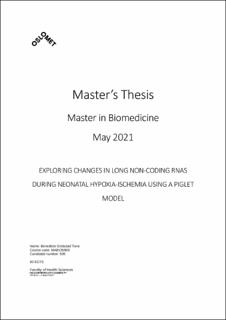Exploring changes in long non-coding RNAs during neonatal hypoxia-ischemia using a piglet model
Master thesis
Published version
Permanent lenke
https://hdl.handle.net/11250/2836730Utgivelsesdato
2021Metadata
Vis full innførselSamlinger
Sammendrag
Background: Despite major advances in research and clinical care during the last decade, hypoxic-ischemic encephalopathy (HIE) remains one of the leading causes worldwide of death and disability in children under five years of age. The disorder is caused by oxygen deprivation (hypoxia) and decreased blood flow (ischemia) (HI) to the brain during the birth process. However, not only oxygen deficiency, but also excess oxygen supply (hyperoxia) during the reoxygenation period can increase oxidative stress and contribute to increased morbidity or various life-long disabilities. Consequently, early and reliable biomarkers to detect the severity and predict the overall outcome of neonatal HI are highly demanded. Long non-coding RNAs (lncRNAs) are non-protein-coding RNA transcripts with key regulatory properties. Changes in their expression indicate a variety of diseases, conditions, and biological processes, including cancer, oxidative stress, and hypoxia. Aim of study: This thesis intended to explore specific lncRNAs as potential markers for the severity of neonatal hypoxia-ischemia using a neonatal piglet model. Material and methods: A total of 42 newborn piglets were randomized into four study arms: 1. hypoxia-normoxic reoxygenation, 2. hypoxia-3 minutes of hyperoxic reoxygenation, 3. hypoxia-30 minutes of hyperoxic reoxygenation, and 4. sham-operated control. The identified lncRNAs BDNF-AS, H19, MALAT1, ANRIL, TUG1, PANDA, and related target genes were investigated by qPCR to determine the RNA expression alterations in the cortex, hippocampus, white matter, and cerebellum after exposure to severe hypoxia versus control. BDNF-AS, H19, MALAT1, and ANRIL were chosen for å more detailed analysis to estimate the time-dependent effect of hyperoxic exposure versus normoxic reoxygenation in the cortex. The results of BDNF-AS and H19 were validated by a second, independent method (Droplet Digital PCR, ddPCR). Results: A significant increase of BDNF-AS, H19, MALAT1, and ANRIL was observed in various brain regions of piglets exposed to severe hypoxia compared to the control. A so far unknown, striking enhancement in BDNF-AS expression levels in piglets exposed to short or long periods of hyperoxic reoxygenation emerged from this study, indicating an increased level of hyperoxic and oxidative stress when resuscitated with supplementary oxygen. Conclusion: The lncRNAs BDNF-AS, H19, MALAT1, ANRIL, TUG1, and PANDA were differentially expressed in a newborn piglet model of hypoxia-ischemia. Specific changes in the expression of BDNF-AS could be related to both deficiency and excess of oxygen, suggesting further studies to verify the potential use of this lncRNA as a biomarker for oxidative stress damage and the severity of perinatal hypoxia-ischemia in the future.
